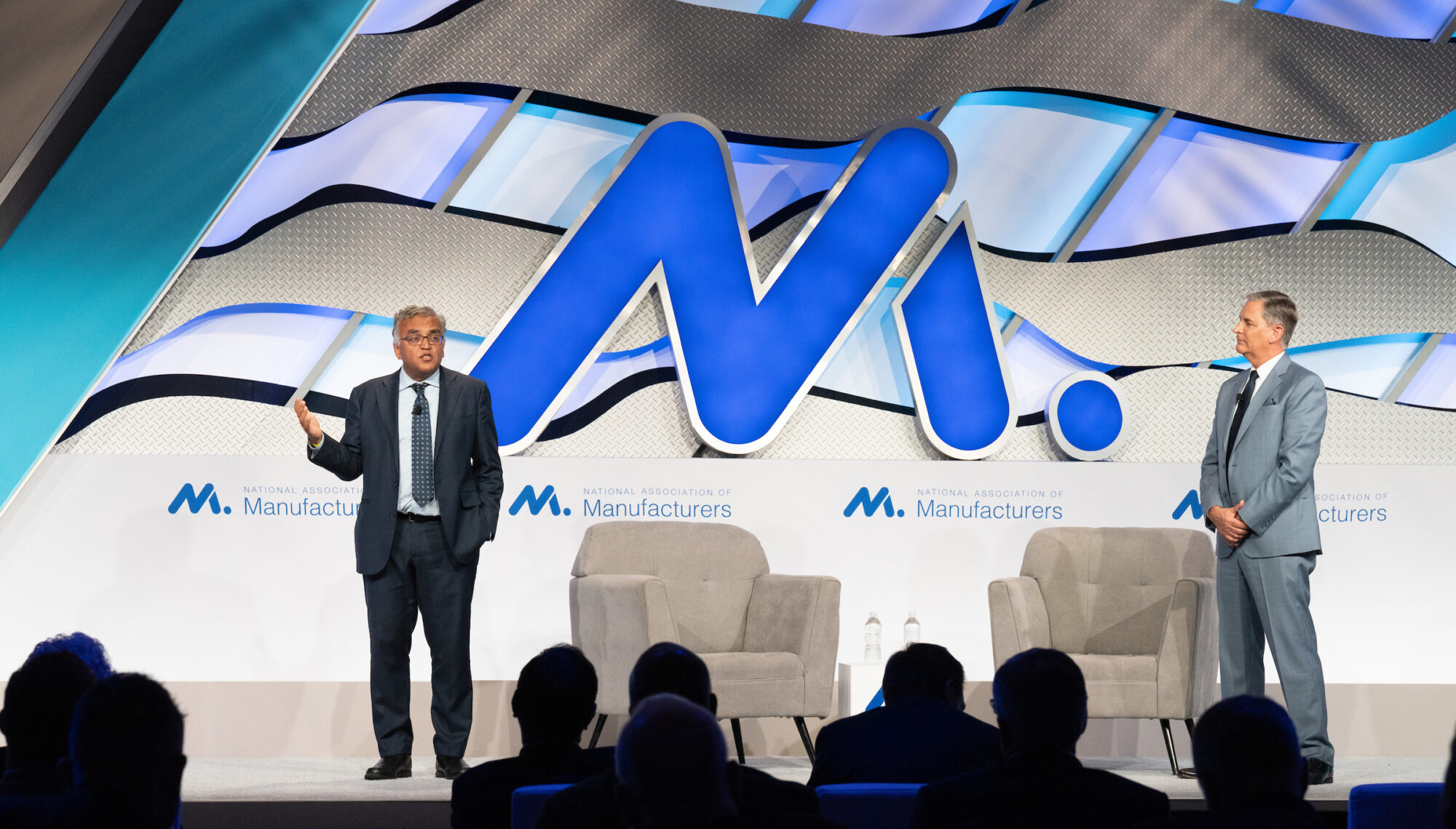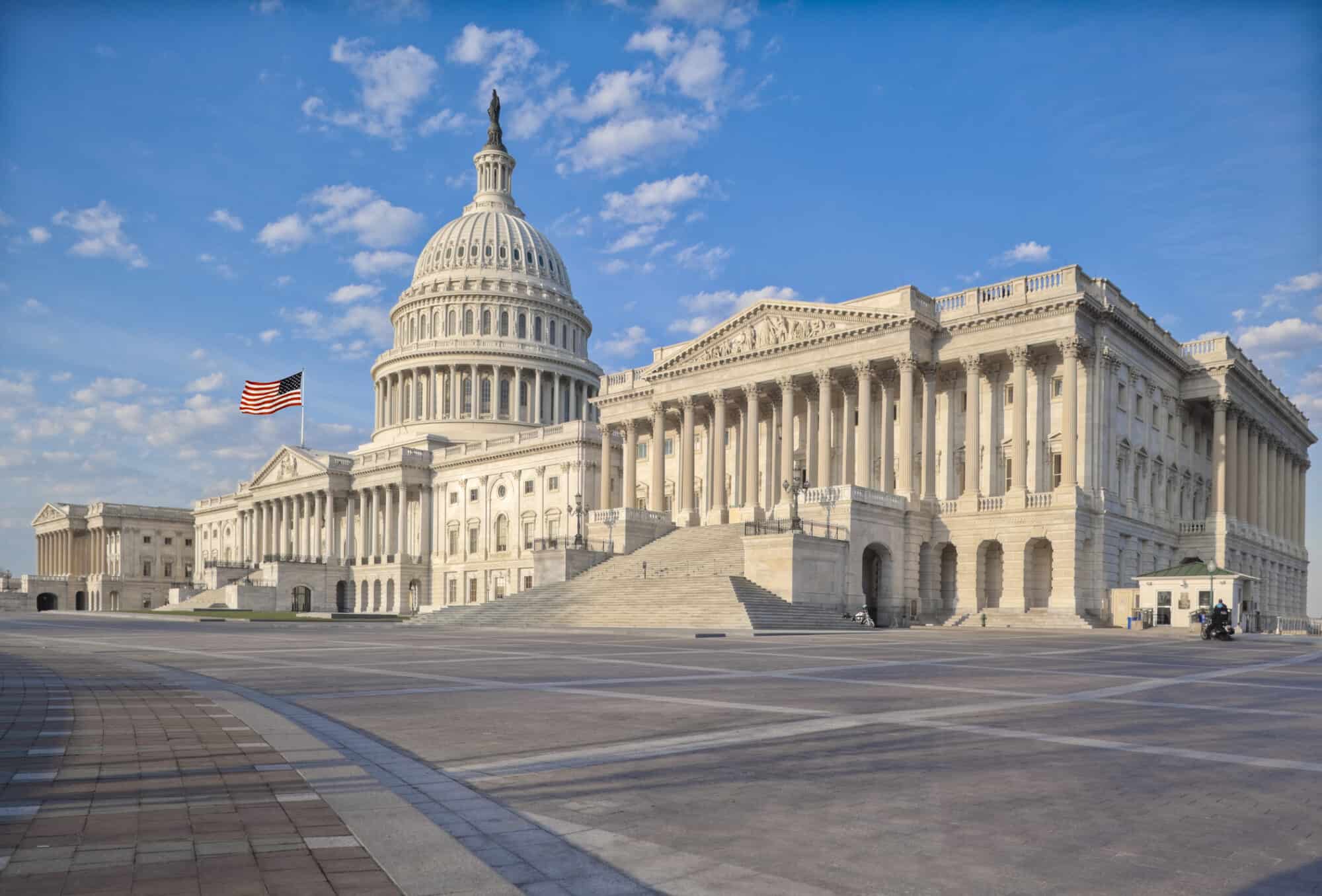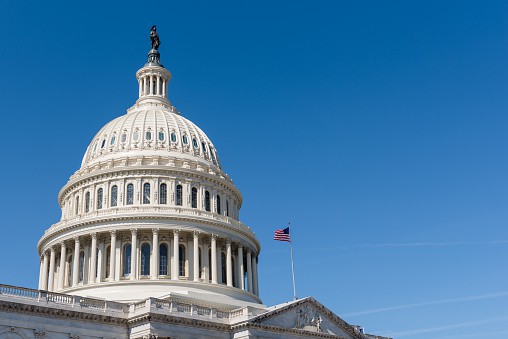NAM Achieves Victory in Proxy Suit

The NAM notched a significant legal victory yesterday when a federal judge vacated the Securities and Exchange Commission’s suspension of a 2020 rule regulating “proxy advisory firms.”
The background: Proxy firms advise institutional investors on how to vote their shares in publicly traded companies, but those firms have long been unregulated and unaccountable.
- In 2020, in large part through the advocacy of the NAM, the SEC finalized a rule increasing oversight of these firms—but in 2021, the SEC’s new leadership announced that the agency would not enforce the rule.
- Suspending the rule without public notice and comment was a violation of administrative law—and the NAM stepped up to challenge this circumvention of the Administrative Procedure Act in court.
The win: Yesterday, the NAM won its case against the SEC in the U.S. District Court for the Western District of Texas. The decision makes clear that the SEC acted unlawfully by suspending the compliance date for the proxy firm rule without following the notice-and-comment procedures required under the APA.
- As the court said in its opinion, “[agencies] do not have the inherent power to stay or delay a final rule absent notice-and-comment rulemaking.”
What’s next: The NAM has also filed suit against the SEC’s 2022 rescission of critical components of the 2020 rule. That case is still ongoing, with oral arguments scheduled for December—but this week’s decision ensures that the SEC will not be able to re-suspend the 2020 rule if the NAM is successful in its challenge to the rescission.
Our take: “Today’s decision is a victory for the rule of law, and the NAM Legal Center was proud to lead this effort for the industry,” said NAM Chief Legal Officer Linda Kelly. “Federal agencies are bound by the Administrative Procedure Act—standards the SEC failed to meet by indefinitely delaying the compliance date for the 2020 proxy firm rule without notice-and-comment rulemaking. Manufacturers depend on regulators to promulgate and enforce reliable rules of the road, and the NAM looks forward to similarly holding the SEC to account in our ongoing case against the agency’s unlawful rescission of the 2020 rule.”
Manufacturers Celebrate Victory in NAM v. SEC
Judge Overturns SEC’s Suspension of 2020 Proxy Firm Rule
Washington, D.C. – Following a decision granting the National Association of Manufacturers’ motion for summary judgment in NAM v. SEC and vacating the Securities and Exchange Commission’s unlawful suspension of its duly promulgated proxy advisory firm rule, NAM Chief Legal Officer Linda Kelly released the following statement:
“Today’s decision is a victory for the rule of law, and the NAM Legal Center was proud to lead this effort for the industry. Federal agencies are bound by the Administrative Procedure Act—standards the SEC failed to meet by indefinitely delaying the compliance date for the 2020 proxy firm rule without notice-and-comment rulemaking. Manufacturers depend on regulators to promulgate and enforce reliable rules of the road, and the NAM looks forward to similarly holding the SEC to account in our ongoing case against the agency’s unlawful rescission of the 2020 rule.”
Background:
The NAM has long called for increased oversight of proxy advisory firms. In July 2020, the SEC issued final regulations to enhance transparency and accountability for proxy firms, a move NAM President and CEO Jay Timmons called a “long-sought, major win for the industry and millions of manufacturing workers.” In October 2020, the NAM filed a motion to intervene in ISS v. SEC (ISS’s attempt to overturn the rule) in support of these reforms.
In June 2021, the SEC announced that it was suspending enforcement of the 2020 rule; the NAM filed suit against the SEC in October 2021 challenging this unlawful suspension. The U.S. District Court for the Western District of Texas today issued an opinion granting the NAM’s motion for summary judgment and vacating the SEC’s suspension of the rule. As the court explained, “[Agencies] do not have the inherent power to stay or delay a final rule absent notice-and-comment rulemaking.”
In July 2022, the SEC rescinded critical portions of the 2020 rule, a move that Timmons said “epitomizes ‘arbitrary and capricious’ rulemaking.” The NAM has filed suit challenging the rescission; a summary judgement hearing in NAM v. SEC is scheduled for December 9, 2022.
-NAM-
The National Association of Manufacturers is the largest manufacturing association in the United States, representing small and large manufacturers in every industrial sector and in all 50 states. Manufacturing employs more than 12.8 million men and women, contributes $2.77 trillion to the U.S. economy annually and accounts for 58% of private-sector research and development. The NAM is the powerful voice of the manufacturing community and the leading advocate for a policy agenda that helps manufacturers compete in the global economy and create jobs across the United States. For more information about the NAM or to follow us on Twitter and Facebook, please visit www.nam.org.
Action Needed on Interest Deductibility, NAM Study Shows

An important new study released by the NAM shows that failure to reverse a new, stricter limit on interest deductibility could cost the United States nearly half a million jobs.
The background: Manufacturing is a capital-intensive industry—and manufacturers often borrow funds to purchase capital equipment and invest in growth. The interest they pay on those loans is tax deductible up to a certain limit. However, a recent change in tax law modified the way that limit is calculated—leaving companies with a smaller deduction and increased costs as they seek to invest in equipment and job creation.
The data: The study published by the NAM paints a bleak picture of the economic impact if Congress fails to take action to fix this problem. According to the EY analysis, keeping a stricter interest deduction in place would increase manufacturers’ cost of capital and lead to reduced investments in the U.S. economy. The result would be lost jobs, reduced employee compensation and lessened U.S. GDP. Specifically, the study finds that the stricter interest limitation will cost the United States:
- 467,000 jobs;
- $23.4 billion of employee compensation; and
- $43.8 billion in GDP.
What’s next: The NAM supports the Permanently Preserving America’s Investment in Manufacturing Act (H.R. 5371/S. 1077), bipartisan legislation that would reverse the stricter limitation and ensure that manufacturers can make critical investments in themselves and their communities.
What we’re saying: “These numbers show the importance of preserving manufacturers’ ability to deduct interest and finance critical job-creating investments,” said NAM Senior Director of Tax and Domestic Economic Policy Charles Crain. “With 467,000 jobs at risk, the NAM is leading the effort to secure a reversal of this harmful change by year’s end.”
Building Infrastructure That Works

As supply chain disruptions and industrial shipping challenges of the past few years have proven, the U.S. infrastructure network is in dire need of a comprehensive overhaul. That’s why it’s a key focus of the NAM’s “Competing to Win” policy roadmap.
Turnkey fixes: “Competing to Win,” which focuses on immediately implementable solutions for congressional leaders in 12 policy arenas, enumerates a wide range of policies that will bolster manufacturers’ competitiveness.
Historic and bipartisan: With its $1.2 trillion investment, last year’s Infrastructure Investment and Jobs Act provided a solid foundation for upgrading roads, airports, bridges, ports, railroads and more.
- In fact, much of the final legislative text of the IIJA resembled proposals included in “Building to Win,” the NAM’s blueprint for modernizing our transportation, energy, water and digital infrastructure.
- The legislation contains nearly $550 billion in new federal appropriations for projects ranging from bridge and highway updates to significant broadband expansion and community climate resilience efforts.
The NAM’s plan: The NAM’s latest policy prescriptions are commonsense ideas that will help policymakers make the best use of the IIJA and enhance American competitiveness. Here’s a quick tour of the most important aspects it addresses.
Funding: The first order of business is paying for the upgrades. Policymakers should modernize user fees that support road and runway projects with much-needed funding.
Efficiency: Next up is fixing the all-too-sluggish pace of infrastructure projects. Some of the NAM’s recommendations:
- Keep improving the broken permitting process to decrease time-consuming reviews and eliminate burdensome costs.
- Clear the extensive backlog of essential infrastructure projects that are already in the planning process and awaiting final approval.
- And last, streamline regulatory agencies’ processes so that key transportation projects don’t get tripped up by more red tape.
Flexibility: Public–private partnerships and innovative collaboration between industry and government should play a large role in these upgrades, but not every approach is universal. Policymakers should maintain key funding sources and keep the federal government involved but retain a results-oriented focus to improve our nation’s infrastructure.
The last word: “‘Competing to Win’ builds on the historic gains made through last year’s Infrastructure Investment and Jobs Act and presents policymakers with a roadmap for improving American economic prosperity,” said NAM Vice President of Infrastructure, Innovation and Human Resources Policy Robyn Boerstling.
- “Manufacturers are the backbone of our national industrial base and rely on all parts of the transportation supply chain to create, assemble and ship to market essential products and consumer goods. The steps outlined in this plan are commonsense and will generate the economic growth needed to enhance American companies’ competitiveness in a global marketplace.”
Dr. Ashish Jha on the Next Phase of Pandemic Response

This winter, we might be facing both a difficult flu season and another surge of COVID-19. How can manufacturers help protect workers and all Americans from illness, hospitalization or worse? Dr. Ashish Jha, the White House COVID-19 response coordinator, gave a comprehensive answer at an NAM gathering of manufacturing leaders last week. Here’s what he had to say.
The situation today: Though both COVID-19 infections and deaths are down, Jha noted that if we keep steady at today’s numbers, we’ll be seeing 100,000 to 150,000 deaths per year—three to five times worse than the average flu season.
- However, “almost every one of those deaths is preventable,” he emphasized. In fact, we are better able to fight COVID-19 than the flu, as we have more effective treatments for the former.
- If we take some proactive measures, Jha added, we can “drive the death number down 90%.”
What to expect: The near future is rather worrying, according to Jha. The combination of COVID-19 and flu stands to hit us hard this winter.
- We’ve had two seasons in a row with “little to no flu”—in large part thanks to COVID-19 mitigation measures like masking and avoiding large gatherings.
- This year, however, people have largely stopped masking and are back to congregating in person. And there is reason to expect a COVID-19 wave anyway, as infections spiked during both the past two winters.
- Meanwhile, there are alarming indications that this flu season will be harsh. Jha noted that public health officials watch the southern hemisphere during our summer (their winter) to see what our flu season may be like—and this year, the southern hemisphere had an “early and robust flu season.”
- In addition, the health care workforce is truly exhausted after more than two years of the pandemic. “There’s no question that this is potentially challenging,” Jha concluded.
What to do: As alarming as the situation might be, Jha says there is “good news” as well. “We can actually control and prevent a large chunk of what might be coming down the path,” he said, as long as we focus on three key measures.
Vaccines: This is the big one. Getting people vaccinated against COVID-19 and flu is essential, said Jha, and the new BA.5-specific COVID-19 shots will make a big difference.
- The U.S. is the first country to authorize such a shot, and that means we now have a “vaccine that exactly matches the dominant variant” and that offers much better protection for today’s environment than the original vaccines.
- Jha praised manufacturers’ and the NAM’s efforts to encourage workers to get vaccinated and urged manufacturers to continue their efforts this season, including by offering paid time off for workers getting vaccinated.
Treatment: The second essential element is treatment. As Jha explained, we have very effective treatments for COVID-19, including antivirals and monoclonal antibodies. We must make sure that people have easy access to them, via test-and-treat sites and telehealth, for example. Employers can also help workers get these lifesaving treatments, he added.
- These medicines not only prevent hospitalizations and deaths, but also help people “clear the infection faster, so they feel better faster.”
- “There is some preliminary evidence that they also prevent long-term complications like long COVID as well,” Jha added.
Air quality: Last, Jha cited the importance of improving air quality to combat all respiratory infections, whether COVID-19, influenza or RSV (a common respiratory virus).
- Most Americans spend 90% of their time indoors, but don’t really think about the quality of the air they’re breathing, he noted.
- Yet, that air quality helps determine your likelihood of getting sick, and even “makes a difference to your cognition,” he pointed out. Research shows that improving air quality raised students’ test scores in schools and reduced worker absences.
- We can improve indoor air quality by upgrading filters, improving air exchanges with the outdoors or using air purifiers, he advised.
The long term: “The virus will continue evolving, and that means we need a long-term strategy for building people’s immunity,” said Jha.
- The next generation of vaccines—including nasal vaccines that block transmission and “variant-proof” vaccines—will truly put COVID-19 behind us. And we need to develop these vaccines fast, via a partnership between the government and private sector, he said.
- Improving indoor air quality will also have a huge long-term impact, he added, as the economy loses tens of millions of dollars from worker absences due to illness.
- “We should use this moment, with all that we have learned from this pandemic, to build a healthier society,” he said.
The last word: In conclusion, Jha said, “Let me wrap up by saying thank you for the incredible leadership so many of you have shown in bringing our country as far forward as it has come.”
- “This next set of challenges is every bit as big as the original,” he warned. Yet, when the public and private sector work together, they “can accomplish enormous things,” like the development and deployment of the COVID-19 vaccines.
- “My hope is that we can continue doing that work together. And if we do, we can certainly get through this fall and winter without disruption, without a lot more sickness . . . and get our country to a much better, healthier and more productive place.”
New Study | Stricter Interest Expense Limits Costs Half Million Jobs
Failing to Address EBIT-Based Limitation Harms Manufacturers’ Competitiveness
Washington, D.C. – Following the release of an analysis on the economic impact of failing to reverse a stricter limitation on deductions for interest on business loans that took effect earlier this year, National Association of Manufacturers Managing Vice President of Tax and Domestic Economic Policy Chris Netram released the following statement.
Key Findings:
The stricter EBIT-based 163(j) interest expense limitation before market adjustments would cost:
- 467,000 jobs;
- $23.4 billion of employee compensation; and
- $43.8 billion in GDP.
“Manufacturers are already facing incredible economic headwinds due to increased input costs, rising interest rates, labor shortages and snarled supply chains. This analysis shows that failing to reverse the damaging change to the tax treatment of interest on business loans disproportionately harms manufacturers at a perilous time—costing hundreds of thousands of jobs and billions of dollars in economic growth.
“America is an international outlier in imposing such a strict interest expense limitation. With nearly half a million American jobs at stake, Congress must act by year’s end to reverse the stricter EBIT-based limitation and allow manufacturers to continue to invest for growth.”
EY’s Quantitative Economics and Statistics group prepared the analysis.
Background:
Prior to 2022, the interest expense limitation was calculated based on a company’s earnings before interest, tax, depreciation and amortization (EBITDA). This year, a stricter limitation based on a company’s earnings before interest and tax (EBIT) took effect. By excluding depreciation and amortization from the calculation, the stricter limitation increases the tax burden on manufacturers that make investments in long-lived capital equipment.
-NAM-
The National Association of Manufacturers is the largest manufacturing association in the United States, representing small and large manufacturers in every industrial sector and in all 50 states. Manufacturing employs more than 12.8 million men and women, contributes $2.77 trillion to the U.S. economy annually and accounts for 58% of private-sector research and development. The NAM is the powerful voice of the manufacturing community and the leading advocate for a policy agenda that helps manufacturers compete in the global economy and create jobs across the United States. For more information about the NAM or to follow us on Twitter and Facebook, please visit www.nam.org.
Kigali Ratification a Win for Manufacturers

The Senate voted yesterday to ratify the Kigali Amendment—an international greenhouse gas–reduction accord that is more meaningful than any the U.S. had agreed to before. Long advocated by the NAM, this ratification is a major step forward for manufacturers and their ability to compete effectively and sustainably.
A climate-action model: In a strong bipartisan 69–27 vote, the Senate approved the amendment, a change to the 1987 Montreal Protocol that phases down the use of hydrofluorocarbons (commonly used refrigerants) in favor of more efficient next-generation alternatives.
- The measure, which the NAM called for in its climate change roadmap, “The Promise Ahead,” “could help avoid a half-degree Celsius of global temperature increases by the end of this century,” according to POLITICO Pro’s E&E News (subscription).
- The ratification builds on a move for which manufacturers also pushed, the 2020 legislation requiring the Environmental Protection Agency to issue rules to phase down nonessential HFCs by 85% by 2036.
Manufacturers approve: Many manufacturers were delighted by this move. “Trane Technologies applauds senators on both sides of the aisle for voting to ratify the Kigali Amendment,” Trane Technologies Chair and CEO Dave Regnery told Input.
- “In addition to creating 33,000 U.S. jobs, stimulating $12.5 billion in new investment in the U.S. economy and boosting U.S. exports by 25%, ratifying Kigali aligns with our bold commitments to reduce emissions through sustainable innovation.”
Accountability for China, India: Critically, the legislation fortifies “our global leadership and put[s] the U.S. in a position to hold countries like China and India accountable,” NAM Vice President of Energy and Resources Policy Rachel Jones said in a communique to Congress—which was quoted by Environment & Public Works Committee Chairman Sen. Tom Carper (D-DE) on the Senate floor Tuesday.
- The amendment will also “protect American workers, grow the economy and improve our trade balance all while encouraging further innovation to strengthen America’s technology leadership,” Jones wrote.
Inside the NAM’s advocacy: “We were able to leverage our longstanding policy experience, strategic partnerships and our depth of relationships in the Senate to adeptly navigate the ever-changing and challenging politics,” said NAM Senior Vice President of Policy & Government Relations Aric Newhouse.
- “Ultimately, the NAM’s support and long-term engagement was able to shepherd this crucial priority for manufacturers across the finish line in a bipartisan way that doesn’t force a false choice between environmental protection and economic growth.”
The last word: “This action proves that if we work together—if we rise above politics and partisanship and focus on solving problems—we can make our vision of a brighter tomorrow into reality,” Jones said in a statement.
Manufacturers: Kigali Ratification a Blueprint for Bipartisan Climate Action
Washington, D.C. – Following the Senate’s 69–27 vote to ratify the Kigali Amendment to the Montreal Protocol, National Association of Manufacturers Vice President of Energy and Resources Policy Rachel Jones released the following statement:
“The Senate’s vote to ratify the Kigali Amendment is a blueprint for the type of bipartisan climate action that meets science-based targets while strengthening manufacturing competitiveness. It will reduce emissions by the equivalent of 80 billion metric tons of CO2 by 2050, with the potential to create up to 150,000 more U.S. jobs by 2027. This action proves that if we work together—if we rise above politics and partisanship and focus on solving problems—we can make our vision of a brighter tomorrow into reality.
“Manufacturers have supported the ratification of the Kigali Amendment for years. This treaty will be a boon for manufacturing, for global trade and for products that protect health, safety, comfort and productivity worldwide. Ratification further strengthens our global leadership on the phasedown of hydrofluorocarbons and will help the U.S. hold countries like China and India accountable on emissions. This shows that we can tackle climate change while strengthening our global competitiveness as we deploy next-generation technologies.”
-NAM-
The National Association of Manufacturers is the largest manufacturing association in the United States, representing small and large manufacturers in every industrial sector and in all 50 states. Manufacturing employs more than 12.8 million men and women, contributes $2.77 trillion to the U.S. economy annually and accounts for 58% of private-sector research and development. The NAM is the powerful voice of the manufacturing community and the leading advocate for a policy agenda that helps manufacturers compete in the global economy and create jobs across the United States. For more information about the NAM or to follow us on Twitter and Facebook, please visit www.nam.org.
What Manufacturers Need from Regulatory Reform

While smart regulations can enhance manufacturers’ competitiveness, there are far too many cases of unwieldy or unnecessary rules getting in their way. That’s why the NAM is standing up for regulatory reform and providing policymakers with a list of solutions to pursue today.
The challenge: The annual regulatory cost burden for an average U.S. firm represents 21% of its payroll, forcing manufacturers to divert resources away from important investments. For smaller manufacturers, the burden can be disproportionately painful, creating barriers to growth and development.
Our work: At the NAM, we’re advocating for a predictable regulatory agenda that is based on science and facts and that offers flexibility for innovation.
- The NAM’s agenda, contained in its policy blueprint Competing to Win, seeks to combat the fundamental problems in our outdated regulatory system.
- That includes ensuring that regulations focus on outcomes and rely on data; improving regulatory analysis; minimizing unnecessary burdens; strengthening industry outreach; preserving the ability of companies to grow; and reducing the abuse of our legal system.
What we’re saying: “Manufacturers in the United States should be able to grow, compete and win without being stymied by outdated and unnecessary regulations,” said NAM Director of Regulatory, Tax and Domestic Economic Policy Alex Monié.
- “We are proud of the work that the NAM has done to reduce the burden on businesses while also protecting the men and women who make things in America.”
- “We are committed to pressing forward so that every manufacturer can support their workforce, participate in market innovation, contribute to their communities, promote competitiveness and advance U.S. leadership.”
Learn more: Check out the NAM’s full regulatory reform agenda in Competing to Win—a strategic blueprint for the policies that manufacturers in America need to compete with the rest of the world.
NAM Competes to Win on Taxes

The NAM is leading the way forward on a range of policies to help boost innovation, opportunity and competitiveness for manufacturers in the United States—and that includes tax policies that ensure manufacturers can continue to compete and win.
The record: During tax reform, the NAM achieved its key priorities—a lower corporate income tax rate, a reduced tax burden on pass-through business income, the adoption of a modern territorial tax system, the retention of the R&D tax credit and the adoption of incentives for capital equipment purchases.
- Thanks to a more competitive tax code, manufacturers across America have been investing in jobs, facilities and their communities.
The road ahead: Of course, the NAM isn’t taking its eye off the ball. We are committed to protecting our gains and furthering progress—and that means ensuring the tax code continues to incentivize manufacturers’ ability to invest in innovation and growth. We’re focusing on three important tax priorities in the months ahead.
Research and development: On Jan. 1 of this year, a harmful tax change went into effect that makes R&D more expensive in the United States by requiring businesses to deduct their R&D expenses over a period of years.
- The NAM has been leading the charge to ensure the tax code continues to support innovation by allowing businesses to fully deduct their R&D expenses in the year in which they are incurred. Check out these company stories on the importance of tax policies that support R&D.
Interest deductibility: When manufacturers borrow funds to buy capital equipment, the interest they pay on those loans is tax deductible up to a certain limit. But a recent change in the tax law modified how that limit is calculated—shrinking the deduction, making debt financing more expensive and leaving less capital for job creation and investment.
- The U.S. is the only OECD country with such a strict interest limitation, so the NAM is working with members of both parties in Congress to reverse the new limit calculation and enhance manufacturers’ ability to compete. Read more about the NAM’s work on this provision here.
Full expensing: Under present law, manufacturers can deduct 100% of their investments in assets with long useful lives, supporting their ability to acquire vital equipment and strengthening their competitiveness. However, the ability to deduct 100% of these costs begins to phase down at the beginning of 2023 and is set to completely expire in 2027.
- The NAM is leading the business community in advocating for full expensing permanency, joining with members of Congress to support legislation that would create certainty for manufacturers. See how full expensing has benefited small manufacturers in the United States here.
The last word: “The NAM is fighting to protect manufacturers across the country,” said NAM Senior Director of Tax Policy David Eiselsberg. “Protecting R&D, interest deductibility and full expensing will provide the tax certainty necessary for manufacturers to continue to invest in jobs and growth.”
Learn more: Check out the NAM’s full tax agenda in “Competing to Win.”
